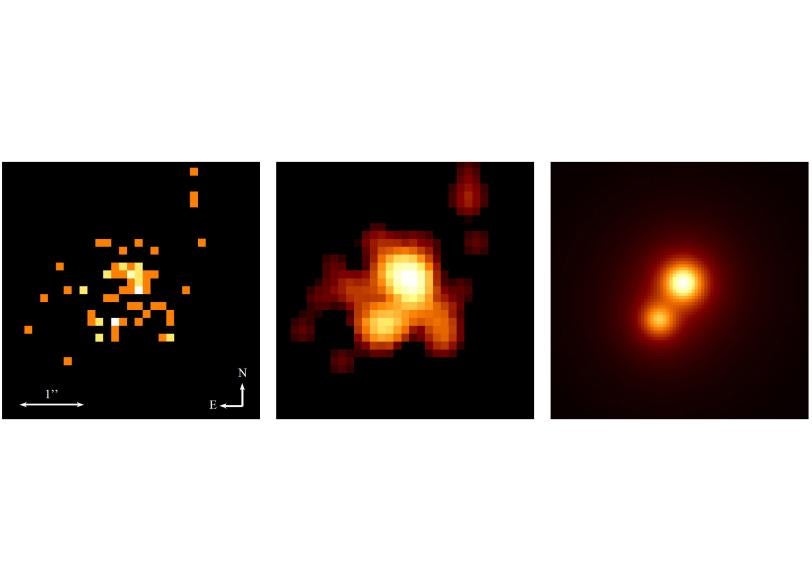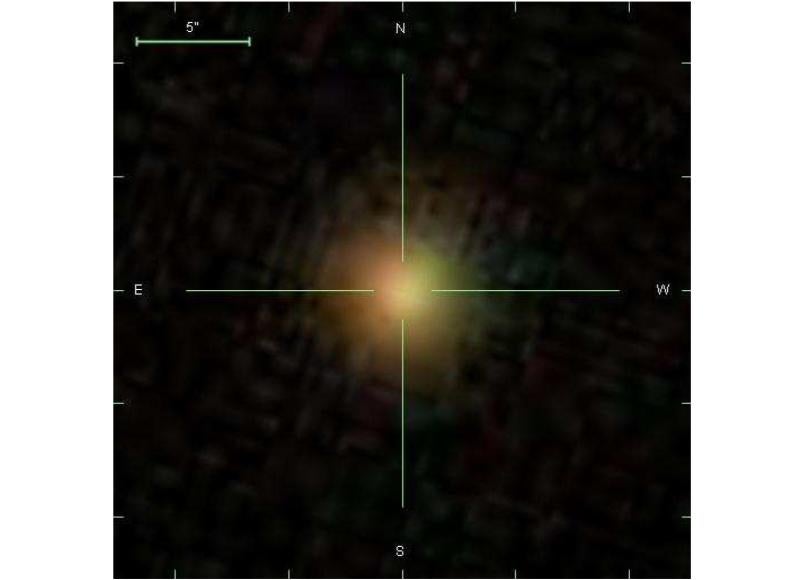KIPAC Researchers Track Binary Black Holes
Two scientists from the Kavli Institute for Particle Astrophysics and Cosmology have been testing a method to look past the intense radiation pouring out of merging galaxy pairs to see the supermassive black holes at their cores.
By Lori Ann White
Two scientists from the Kavli Institute for Particle Astrophysics and Cosmology have been testing a method to look past the intense radiation pouring out of merging galaxy pairs to see the supermassive black holes at their cores. The researchers want to track how black holes located in the centers of merging galaxies spiral in toward each other until they also join, forming a single even-more-massive black hole. This can give astronomers valuable information about galactic evolution, and about how some black holes – and some galaxies – grew so large so early in the history of the universe. Their research will appear in The Astrophysical Journal Letters.
"The whole issue of two lighter black holes combining into a more massive black hole has been hypothesized for some time," said Brian Gerke, formerly of KIPAC and now a scientist with the Environmental Energy Technology Division of Lawrence Berkeley National Lab. Confirming – or disproving – that hypothesis, not to mention putting some numbers on how often it happens if it does, is important for determining the way galaxies develop.
"Early on in the universe," added Greg Madejski, Gerke's KIPAC colleague, "we already see very massive black holes. Could that have happened though slow and steady growth? Probably not. Coalescence –" in other words, by merger " – that's how astronomers think it must have happened."
Actually finding instances of such mergers has been difficult due to the nature of the galaxies involved. The black hole pairs Gerke and Madejski look for are at the heart of active galactic nuclei (AGNs), which are responsible for some of the most energetic phenomena in the universe. The energy comes from gas and dust swirling into the black hole at the heart of an AGN; as the matter is sucked in, it's heated enough to give off electromagnetic radiation from all across the spectrum – from warm infrared radiation to highly-energetic X-rays.
If the black holes are still relatively far apart, they can be distinguished by direct observation. But if the merger happened far enough in the past that the resulting galaxy appears – on its face –relatively placid, then the black holes are too close to tell apart using conventional observation methods.
The team, including frequent collaborator Julie Comerford from the University of Texas at Austin and her colleague Dave Pooley along with Gerke and Madejski used a new, efficient three-step method first proposed by Gerke in a 2009 paper to see past the glare of an active nucleus.
Step one: Comb through data from galactic surveys such as the Sloan Digital Sky Survey, looking for certain spectral properties that could indicate dual AGNs.
The team found a galaxy with the catchy name of SDSS J171544.05+600835.7 that outwardly showed little evidence of being the result of a merger, but its spectrum showed some of the right characteristics. A promising test case, but more checking was necessary because similar characteristics can also be caused by jets of gas shooting out in opposite directions from the neighborhood of a single supermassive black hole.
Step two: Take more detailed spectra of candidate galaxies with ground-based telescopes. In this instance, the team started at Lick Observatory on nearby Mount Hamilton and worked their way up to the Keck Observatory on Mauna Kea.
The team determined that the interesting part of the galaxy's spectrum came from two different sources about 1.9 kiloparsecs apart.
Step three: use this evidence to get valuable observing time on NASA's Chandra X-ray Observatory to see if there are two X-ray sources in the same locations as the sources of the emission lines.
In this case, Chandra did indeed see two X-ray sources but, said Gerke, "We don't have quite enough data to say definitely that they're two AGNs." Gerke doesn't sound disappointed. The team has other candidates they're checking, plus additional observations of this object which can settle the matter. "We're still in the stage of 'Just find them. Find as many dual AGNs as you can," Gerke continued.
Madejski looks forward to the day astronomers have identified a substantial population of merging or newly merged AGNs with dual supermassive black holes. "That could reveal the unknown signs of coalescing black holes."
Roger Blandford, director of KIPAC, is interested in one theorized sign of coalescing black holes – a burst of gravitational waves, strong enough to be detected by future space-based instruments. "Understanding how common black hole mergers are will help with the design of space observatories to detect them."
The team's method should help speed that day's arrival – especially the use of multiple small, ground-based observatories to pin down good candidates. "Observations with smaller scopes, such as the one we used at Lick, are not expensive," Madejski explained; in other words, it's far easier to get time on them than on one of NASA's Great Observatories. But the results they delivered were good enough to get the team time on one Great Observatory – Chandra.
In fact, said Madejski, "We just learned we got more Chandra observations approved for the next cycle – good news!"

